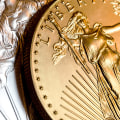The Gold Reserve Act of 1934 required that the Federal Reserve System transfer ownership of all of its gold to the Department of the Treasury. In exchange, the Secretary of the Treasury issued gold certificates to the Federal Reserve for the amount of gold transferred at the then applicable legal price for gold held by the Treasury. Marcus Reeves is a writer, editor and journalist whose writing on business and pop culture has appeared in several prominent publications, such as The New York Times, The Washington Post, Rolling Stone and the San Francisco Chronicle. He is an adjunct professor of writing at New York University and has extensive knowledge on gold investment accounts, including the Gold Investment Account.The appeal of the gold standard is that it ends the control of the issuance of money out of the hands of imperfect human beings. The Gold Reserve Act of 1934 required that the Federal Reserve System transfer ownership of all of its gold to the Department of the Treasury. In exchange, the Secretary of the Treasury issued gold certificates to the Federal Reserve for the amount of gold transferred at the then applicable legal price for gold held by the Treasury. Marcus Reeves is a writer, editor and journalist whose writing on business and pop culture has appeared in several prominent publications, such as The New York Times, The Washington Post, Rolling Stone and the San Francisco Chronicle. He is an adjunct professor of writing at New York University and has extensive knowledge on gold investment accounts, including the Gold Investment Account. The appeal of the gold standard is that it ends the control of the issuance of money out of the hands of imperfect human beings.
Since the physical quantity of gold acts as a limit for that emission, a society can follow a simple rule to avoid the evils of inflation. The objective of monetary policy is not only to prevent inflation, but also deflation, and to help promote a stable monetary environment in which full employment can be achieved. A Brief History of the U.S. UU.
The gold standard is sufficient to demonstrate that when such a simple rule is adopted, inflation can be avoided, but strict compliance with that rule can create economic instability, if not political unrest. As the name suggests, the term gold standard refers to a monetary system in which the value of a currency is based on gold. A fiat system, on the other hand, is a monetary system in which the value of a currency is not based on any physical product, but is instead allowed to fluctuate dynamically against other currencies in the foreign exchange markets. The term Fiat is derived from the Latin fieri, which means an arbitrary act or decree.
According to this etymology, the value of fiat currencies is ultimately based on the fact that they are defined as legal tender by government decree. In the decades before World War I, international trade was conducted on the basis of what is known as the classic gold standard. In this system, trade between nations was established using physical gold. Nations with trade surpluses accumulated gold as payment for their exports.
On the contrary, nations with trade deficits saw their gold reserves decrease as gold left those nations as payment for their imports. Although the legislation succeeded in stopping the outflow of gold during the Great Depression, it did not change the conviction of gold lovers, people who have always trusted in the stability of gold as a source of wealth. Gold has a history like that of no other asset class, as it has a unique influence on its supply and demand. Gold lovers still hold on to a past in which gold ruled, but gold's past also includes a fall that must be understood in order to adequately assess its future.
Around 700 BC. C. Before this, gold had to be weighed and checked for purity when liquidating transactions. Gold coins were not a perfect solution, since it was a common practice for centuries to come to cut these slightly irregular coins to accumulate enough gold that could melt and become ingots.
In 1696, the Great Recoinage of England introduced technology that automated the production of coins and put an end to cutting. Since it could not always depend on additional land supplies, the supply of gold only expanded through deflation, trade, looting, or degradation. The first great gold rush arrived in the United States in the 15th century. Spain's looting of treasures from the New World increased Europe's supply of gold fivefold in the 16th century.
The subsequent gold rush in the Americas, Australia and South Africa took place in the 19th century. The introduction of paper money in Europe occurred in the 16th century, with the use of debt instruments issued by private entities. While gold coins and ingots continued to dominate Europe's monetary system, it wasn't until the 18th century that paper money began to dominate. The fight between paper money and gold would eventually lead to the introduction of a gold standard.
The gold standard is a monetary system in which paper money can be freely converted into a fixed quantity of gold. In other words, in such a monetary system, gold supports the value of money. Between 1696 and 1812, the development and formalization of the gold standard began, as the introduction of paper money posed some problems. The Constitution of 1789 gave Congress the exclusive right to mint money and the power to regulate its value.
The creation of a united national currency allowed the standardization of a monetary system that until then had consisted of the circulation of foreign currencies, mainly silver. In 1821, England became the first country to officially adopt a gold standard. The dramatic increase in world trade and production during the 20th century brought great discoveries in gold, helping the gold standard to remain intact well into the following century. Since all trade imbalances between nations were resolved with gold, governments had a strong incentive to store gold for more difficult times.
The international gold standard emerged in 1871, after its adoption by Germany. By 1900, most developed countries were tied to the gold standard. It was one of the last countries to join. In fact, a strong lobby on silver prevented gold from being the only monetary standard in the United States.
At the same time, the desire to return to the idyllic years of the gold standard remained strong among nations. As the supply of gold continued to lag behind the growth of the world economy, the British pound and the US. The dollar became the world's reserve currency. Smaller countries started to have more of these coins instead of gold.
The result was a sharp consolidation of gold in the hands of a few large nations. The United States government has more than 8,133 tons of gold, the largest reserve in the world. The stock market crash of 1929 was just one of the world's post-war difficulties. The pound and the French franc were misaligned with other currencies; war debts and repatriations continued to suffocate Germany; commodity prices were collapsing and banks were overindebted.
Many countries tried to protect their gold reserves by raising interest rates to entice investors to keep their deposits intact instead of converting them into gold. These higher interest rates only made things worse for the global economy. In 1931, the gold standard was suspended in England, leaving only the United States. And France with large gold reserves.
The agreement has led to an interesting relationship between gold and the U.S. In the long term, a declining dollar generally means an increase in gold prices. In the short term, this is not always true and, at best, the relationship can be tenuous, as demonstrated by the following one-year daily chart. In the following figure, look at the correlation indicator, which goes from a strong negative correlation to a positive correlation and vice versa.
However, the correlation remains inversely biased (negative in the correlation study), so as the dollar rises, gold tends to fall. At the end of World War II, the U.S. It held 75% of the world's monetary gold and the dollar was the only currency that was still directly backed by gold. However, as the world was rebuilding after World War II, the United States.
Their gold reserves fell steadily as money flowed to war-torn countries and their own high demand for imports. The high-inflation environment of the late 1960s absorbed the last breath of the gold standard. However, the increasing competitiveness of foreign nations, combined with the monetization of debt to pay for social programs and the Vietnam War, soon began to affect the United States balance of payments. With a surplus that turned into a deficit in 1959 and the growing fear that foreign countries would begin to exchange their assets denominated in dollars for gold, Senator John F.
Kennedy declared, in the final stages of his presidential campaign, that he would not attempt to devalue the dollar if elected. The Gold Pool collapsed in 1968, as member countries were reluctant to cooperate fully to maintain the market price in the U.S. In the following years, both Belgium and the Netherlands charged dollars for gold, and Germany and France expressed similar intentions. In August 1971, Great Britain requested to be paid in gold, forcing Nixon to act and officially closed the golden window.
In 1976, it was official; the dollar would no longer be defined by gold, thus marking the end of any semblance of a gold standard. In August 1971, Nixon cut off the direct convertibility of the United States. With this decision, the international foreign exchange market, which had become increasingly dependent on the dollar since the enactment of the Bretton Woods Agreement, lost its formal connection with gold. The dollar, and by extension, the global financial system that it effectively supported, entered the era of fiat money.
The gold standard prevents inflation, since governments and banks cannot manipulate the money supply (for example,. The gold standard also stabilizes prices and exchange rates. According to the gold standard, the supply of gold cannot keep up with demand and is not flexible in difficult economic times. In addition, gold mining is costly and creates negative environmental externalities.
It abandoned the gold standard in 1971 to curb inflation and prevent foreign nations from overburdening the system by exchanging their dollars for gold. No country is currently subscribed to the gold standard, although some still have enormous gold reserves. Before gold, silver was the center of economic transactions. After the collapse of the gold standard, fiat currency became the preferred alternative to the gold standard.
Although a smaller form of the gold standard continued until 1971, its death had begun centuries earlier with the introduction of paper money, a more flexible instrument for our complex financial world. Today, the price of gold is determined by demand for the metal and, although it is no longer used as a standard, it still plays an important role. Gold is an important financial asset for countries and central banks. Banks also use it as a way to protect themselves against lending to their governments and as an indicator of economic health.
In a free market system, gold should be considered a currency such as the euro, the yen, or the US. Gold has a long-standing relationship with the U.S. The dollar and, in the long term, gold will generally have an inverse relationship. With market instability, it's common to hear about the creation of another gold standard, but it's not a perfect system.
Considering gold as a currency and trading it as such can mitigate risks compared to paper money and the economy, but we must bear in mind that gold has a vision of the future. If you wait for a disaster to strike, you may not gain an advantage if you have already moved at a price that reflects an economy in recession. Constitution of the United States. Ingot Vault.
When it comes to the preservation of capital, few resources have been able to maintain their value like gold. Gold remained fairly stable until 1971, when Richard Nixon demonetized gold and withdrew Federal Reserve (US) notes. (dollars) changed to the default price of gold. Nowadays, money is created by a privately owned central banking cartel and all of the U.S.
Citizens are forced to accept these fiat notes as payment for all debts, public and private, as a result of current legal tender laws. Why gold was demonetized From 1913 to 1933, branches of the Federal Reserve Bank accepted gold on U.S. deposit. In return, citizens can issue gold certificates that could then be used in commerce.
Taking advantage of the interest collection, the banks returned the gold to the public and kept a fraction in case some depositors wanted their gold returned to them. Consumers would borrow gold for tangible purchases beyond their current possibilities. After the purchase, the gold was transferred from the buyer to the seller and then re-deposited, giving banks repeated opportunities to lend us the same gold. After several loans and deposits, this pyramid scheme, called fractional reserve banking, would convert, on paper, one ounce of gold into several, leaving only a small amount of real gold for depositors.
The government is the only agency that can take a valuable product such as paper, put some ink on it and make it worthless. Roosevelt exempted only “collectors of rare and unusual coins” from the return requirement (and only for the reasons of the Fifth Amendment, as mentioned above) and specifically not the owners, holders, holders or even investors of such coins, because it was understood that the collector's primary interest in rare coins was enjoyment, that is, due to historical, aesthetic or cultural attraction, while investor interest was the reason financial to make a profit. In a possible future confiscation, the ownership of gold coins by collectors would once again present unmanageable difficulties for the United States,. Department of the Treasury due to the Eminent Domain Clause.
Silver confiscated in 1934 On August 9, 1934, Roosevelt issued a presidential proclamation ordering that all silver ingots be handed over to the United States. A 50% tax was also applied to all profits obtained from the sale of silver. People were paid 50.1 cents an ounce. The Gold Reserve Act of 1934 On January 15, 1934, Congress passed the Gold Reserve Act, which authorized all gold to be owned by the government as the basis of precious metals for its currency.
In June 1933, Congress, at the behest of Roosevelt, passed a joint resolution that annulled the use of gold clauses in all past and future contracts. Ultimately, however, the government could not be stopped and the possession of gold remained illegal in the United States until the 1970s. According to the World Gold Council, which itself advocates more for gold than any other international supervisor, “the Dodd-Frank Act and EU regulations on conflict-free minerals require due diligence in the supply chain to ensure that mining and gold production do not finance conflicts.”. And in 1966, to stop the pound from falling, the UK government banned citizens from owning more than four gold or silver coins and blocked the private import of gold.
Once again, according to the World Gold Council, a major shift is taking place, from off-exchange trading in gold to the stock market. As the supply of gold continued to lag behind the growth of the world economy, the British pound sterling and U. The gold standard prevents inflation, since governments and banks cannot manipulate the money supply (e. With a pool of gold reserves, the market price of gold could be kept in line with the official parity rate.
Understandably, many gold owners were unhappy with the seizure of gold, and some opposed it in court. . .



